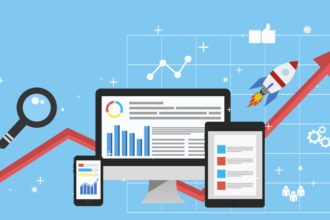The intersection of different forms of technology is becoming more crucial for the future of marketing. One of the biggest changes is the combination of big data and search engine marketing.
Search engine optimization has become a crucial form of marketing over the past 20 years. In addition to providing a steady stream of Internet traffic, SEO also converts very well. The average conversion rate of an SEO visitor is 14.6%, while the conversion rate for social ads is only 1.7%.
Understanding the Role of Data-Driven SEO and SEO
The need for a business to have a website has become very important for many reasons. It is not just for the sake of having an internet presence. Websites are often the first contact between a brand and a prospective customer. A potential customer’s first impression about the website’s interface can either land or cost a brand its new customer. In addition, many website visitors judge the credibility of a company based on its website design. This is one of the reasons that UX design has become so important in recent years.
Also, considering that there are over 1.8 billion websites in existence, any website owner interested in improving their visibility in the search results and optimal usability needs to take data seriously during the design process.
Types of Data Used in Web Design
According to BANG!, a website design company in Phoenix AZ, both quantitative and qualitative data should be utilized during a website design or redesign.
Quantitative data provides the statistics of an event on a website in number, while qualitative data highlights a number of reasons the event might take place.
Data can give insights into the following even before the website is built:
Keyword Research: Google and a variety of 3rd party tools provide data on how often a particular keyword phrase is searched. Doesn’t it make sense to optimize a website to be found for what your customers are actually searching for?
Using keyword research data, the site can be structured with a navigational layout and pages built explicitly to rank for terms analyzed and pre-determined to be the best choices for attracting and converting new customers.
Once a site is up and running, the webserver logs all traffic to the website or a 3rd party tool such as Google Analytics can be used to gather the following data.
The number of Site Visitors: This is the number of people that visit a site. It can be collated daily (24 hours), weekly, and monthly. The statistics of site visitors can be boosted if the website is Search Engine Optimized (SEO). This means it is designed to have a higher chance of appearing on search engines like Google, DuckDuckGo, and Bing. The better the visibility of a site, the higher the number of visits it will receive.
Page Views: Most of the time, the number of visitors on a site does not tally with page views. A website, for instance, may have a daily visitor of 10,000 with over 20,000 page views. This means, on average, each of the site visitors viewed two pages while visiting the site. This, of course, assumes the site has multiple pages. A single page website, page views will be much closer to the number of site visitors.
Bounce Rate: This measures how many visitors view only one page before leaving (bouncing). A user may have come across the site while doing a Google search, but after clicking the link, they only viewed that single page. Some users are likely to stop engaging with your site if the design and layout of the website are not visually appealing.
Time Spent on Site: Just as the name suggests, it is the total amount of time spent by a visitor on a site during a particular visit. This metric is important because it only takes 50 milliseconds (that’s 0.05 seconds) for a user to form the first impression of a website design.
Elements of data-driven web design
It may come as a surprise to many designers, but math and data points can significantly affect the design of a website.
Layout
Using the rule of thirds as an example and 33.333% as a design element makes for elegant and graceful layouts.
The rule of thirds suggests dividing the elements of a webpage into nine parts by drawing an imaginary line 1/3 down from the top, 1/3 up from the bottom, and 1/3 from the left and the right. Those make great “horizon” points horizontally, and the intersections of any of the lines tend to be a focal point making them the ideal spot for a website call to action button to be placed.
Additionally, a website must be clean, uncluttered, and easy to navigate for site visitors. Best practices mean navigating to any page should be available within two mouse clicks.
Text content must be clear and legible, making it easy to read. For instance, you’ll want to contrast between the text color and the background. If text is reversed, i.e., light text on a darker background, you’ll generally want to either enlarge the text 10 to 20%, make the text bold, or both.
Data science regarding color is also important. Research shows different colors will affect the mood of the viewer. Blue and cooler colors, for instance, often have a calming effect and will increase the tendency of the site viewer to place trust in the company. Red and other warmer colors need to be used carefully as large blocks of red are often unpleasant to look at and may even evoke emotions of anger. Small amounts of red or orange work very well to catch the eye and draw them to where we want people to go and, consequently, are often used in call-to-action buttons.
Be careful, though, with who is viewing your website. While black on a website can be classy in the U.S. The color black is associated with death in Japan.
Math is used extensively in the layout of responsive websites that “respond” or adapt to any device, from smartphones to desktop computers. Whether opened on a phone or PC, the user experience is equally great. Responsive design uses a column system of 12 columns. On a desktop, screen content may cover all 12 columns. However, the number of columns is significantly reduced on a smartphone and generally only 3 or 4 columns wide. Content then stacks vertically where on the desktop it may have been in groups 3 or 4 columns wide.
Elements of data-driven SEO first web design
Data should be considered for SEO not only during the design of a site related to keyword phrases but also after it launches. Therefore, SEO should continuously improve the site and rank it higher in the search results.
Thinking about data and your site visitors, if the site’s analytics show a profound interest in a particular topic, you’ll probably want to continue to create more content on that topic.
As an example, if your blog tends to show high numbers of views for a set of topics, by all means, continue writing content or even producing videos on that topic.
SEO and site speed
Internet users always seem to be in a hurry and can be very impatient. So if a site doesn’t load in a few seconds, they’ll be hitting their back button looking for information elsewhere. Which, of course, results in the Page Bounces we covered above. A 3-second delay in page load time can increase bounce rates by as much as 32%.
Google, of course, recognizes this behavior and now rewards quicker websites with increased rankings. In addition, there recent rollout of Core Vitals is intended to measure site speed and ensure an excellent experience for site visitors.
To combat this, a website designer and website developers need to be very conscious of optimizing the site to load quickly. For example, images need to be cropped to the largest size they’ll be displayed at, and using the .webp format for images can decrease the picture’s file size by 60% in BANG’s tests. Smaller file sizes require less time for the page to load.
According to a Google survey, companies with fast-loading websites have about 63% greater chance of attracting smartphone users than competitors with slow-loading websites. Amazon has calculated that one second of page loading can cost it $1.6 billion in sales in a year.
These are just a few examples of how data and analytics play a huge role in website design.
Big Data is Invaluable for SEO-Centric Web Design
Big data and SEO are twin pillars in modern marketing strategies. You need to use big data technology to effectively design your website for maximum SEO benefits. The tips listed above can go a long way towards accomplishing this goal.










